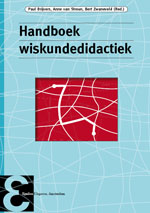Didactiek van de wiskunde. Handboek

|
Didactiek van de wiskunde. Handboek voor leraren in opleiding en in praktijk
Paul Drijvers. Een uitgave van Epsilon |
Het Nederlandse wiskundeonderwijs is volop in beweging. Curricula worden herzien en nieuwe digitale technologieën vinden hun weg naar het klaslokaal. Ook de wiskundedidactiek – de specifieke kennis over het leren en onderwijzen van wiskunde – ontwikkelt zich voortdurend. Over de huidige stand van zaken van dit vakgebied wil dit boek studenten, leraren, lerarenopleiders, auteurs en trainers informeren.
In drie delen biedt dit boek leraren handvatten om hun wiskundig-didactische vaardigheden verder te ontwikkelen. Het eerste deel legt het fundament voor het boek en richt zich op de vraag wat wiskunde is en welke theoretische perspectieven op het leren van wiskunde van belang zijn. Het tweede deel gaat in op thema’s die in alle wiskundelessen een rol spelen zoals vaardigheden, probleemoplossen, contexten, ICT-gebruik en toetsen. Het derde deel zoomt in op specifieke didactieken binnen de domeinen algebra, analyse, statistiek en meetkunde. Denk aan het onderwijzen van het variabelebegrip of de afgeleide functie en aan de intuïtieve valkuilen van de kansrekening. Theoretische inzichten worden toegankelijk gemaakt met aansprekende voorbeelden. Elk hoofdstuk eindigt met een aantal concrete praktijktips, verwijzingen naar bruikbaar lesmateriaal en inspirerende bronnen voor verdere verdieping.
Dit boek vervangt deel 72 (Handboek wiskundedidactiek).

Eindredactie: Paul Drijvers, Anne van Streun, Bert Zwaneveld
Het Nederlandse wiskundeonderwijs ziet er heel anders uit dan in 1974, toen het invloedrijke boek Didactiek van de wiskunde van Joop van Dormolen verscheen: toepassingen en ICT-gebruik hebben bijvoorbeeld een grotere rol gekregen. Daarnaast is ook de wetenschappelijke kennis over leren en onderwijzen van wiskunde enorm uitgebreid. Om deze kennis toegankelijk te maken en verder te ontwikkelen, schreven de universitaire wiskundedidactici in Nederland samen dit handboek voor wiskundedidactiek.
Het Handboek wiskundedidactiek biedt ondersteuning aan de wiskundeleraar die actief aan de slag wil met het verbeteren van het eigen onderwijs. Geen teksten die voorschrijven wat de docent zou moeten doen en hoe dan, maar wetenschappelijk onderbouwde informatie, geïllustreerd met inspirerende voorbeelden om de didactische bekwaamheid verder te ontwikkelen.
Het eerste hoofdstuk schetst een theoretisch kader over het opslaan van kennis in het menselijk geheugen, verschillende vormen van wiskundige kennis die we bij onze leerlingen willen ontwikkelen en de werkwijzen die je daarvoor als wiskundeleraar in de les kunt gebruiken. In de volgende hoofdstukken wordt dit uitgewerkt voor verschillende wiskundige deelgebieden, zoals algebra, analyse, meetkunde, kansrekening en statistiek. Vervolgens komen overstijgende onderwerpen aan bod zoals modelleren, de inzet van ICT en het toetsen van de verschillende leerdoelen. Het laatste hoofdstuk gaat in op het wiskundige denken en de manieren waarop dit kan worden bevorderd.
Inhoudsopgave
1. Leren en onderwijzen van wiskunde
2. Variabelen en vergelijkingen
3. Functies
4. Afgeleide
5. Meetkunde
6. Kansrekening
7. Statistiek
8. Modelleren
9. ICT in het wiskundeonderwijs
10. Wiskundetoetsen
11. Wiskundige denkactiviteiten
- (2023). A new approach to mathematics and data education. A discussion paper (PDF): The Royal Society’s Advisory Committee on Mathematics Education (ACME).
- (2023). Conceptkerndoelen rekenen en wiskunde en toelichtingsdocument (PDF). Enschede: SLO.
- Ainley, J. (2012). Developing purposeful mathematical thinking: a curious tale of apple trees (PDF) PNA, 6(3), 85-103.
- Anderson, J. R. (1995). Cognitive psychology and its implications: Freeman.
- Anderson, J. R. (2000). Learning and memory: Wiley.
- Bargagliotti, A., Franklin, C., Arnold, P., Gould, R., Johnson, S., Perez, L. and Spangler, D. (2020). Pre-K-12 guidelines for assessment and instruction in statistics education (GAISE) report II (PDF): American Statistical Association and National Council of Teachers of Mathematics.
- Barton, C. (2018). How I Wish I’d Taught Maths: Lessons learned from research, conversations with experts, and 12 years of mistakes. Reflections on research, conversations with experts, and 12 years of mistakes: John Catt Educational Ltd.
- Barton, C. (2020). Volgens Barton Lesgeven in wiskunde aan de hand van wetenschap, experts, en 12 jaar aan mislukkingen: Phronese.
- Bednarz, N., Kieran, C. and Lee, L. (Eds.). (1996). Approaches to Algebra. Perspectives for Research and Teaching. (Vol. 18): Springer.
- Bennett, P. W. (2024). Sinking Classrooms: What’s Wrong with “Building Thinking Classrooms” in Mathematics? (PDF), Educhatter.
- Berlinghoff, W. P. and Gouvêa, F. Q. (2016). Wortels van de wiskunde: Epsilon.
- Bethlehem, J. (2018). Nijmegen in de race naar slechtste grafiek ooit (PDF): Peilingpraktijken.
- Boels, L. (2017). Kleintje didactiek: Meetniveaus Euclides, 93(3), 28-29.
- Boels, L. (2019). Het FIzier gericht op… wat elke wiskundedocent zou moeten weten over histogrammen Euclides, 94(4), 10-13.
- Boels, L. (2020). Kleintje didactiek: Continu of discreet Euclides, 95(7), 18-19.
- Clement, J., Lochhead, J. and Monk, G. S. (1981). Translation Difficulties in Learning Mathematics (PDF) The American Mathematical Monthly, 88(4), 286-290 doi:10.2307/2320560.
- Da Ponte, J. P. (1992). The history of the concept of function and some educational implications (PDF) The Mathematics Educator, 3(2), 3-8.
- de Bruijn, N. G. (1946). Eenige beschouwingen over de waarde der wiskunde (PDF): Noordhoff.
- Doorman, M., Drijvers, P., Gravemeijer, K., Boon, P. and Reed, H. (2012). Tool Use and the Development of the Function Concept: From Repeated Calculations to Functional Thinking (PDF) International Journal of Science and Mathematics Education, 10(6), 1243–1267 doi:10.1007/s10763-012-9329-0.
- Drijvers, P. (2019). Embodied instrumentation: Combining different views on using digital technology in mathematics education (PDF). In U. T. Jankvist, M. van den Heuvel-Panhuizen and M. Veldhuis (Eds.), Proceedings of the Eleventh Congress of the European Society for Research in Mathematics Education (CERME11) (pp. 8-28): Freudenthal Group & Freudenthal Institute, Utrecht University and ERME.
- Drijvers, P. (Ed.). (2025). Didactiek van de wiskunde. Handboek voor leraren in opleiding en in praktijk (PDF). Utrecht: Epsilon uitgaven.
- Drijvers, P., Goddijn, A. J. and Kindt, M. (2006). Oriëntatie op schoolalgebra (PDF). In P. Drijvers (Ed.), Wat a is, dat kun je niet weten. Een pleidooi voor betekenisvolle algebra op school (pp. 7-24). Utrecht: Freudenthal Instituut, Universiteit Utrecht.
- Drijvers, P. and Kop, P. (2012). Variabelen en vergelijkingen. In P. Drijvers, A. Van Streun and B. Zwaneveld (Eds.), Handboek Wiskundedidactiek (pp. 53 – 82): Epsilon.
- Drijvers, P., Van Streun, A. and Zwaneveld, B. (Eds.). (2012). Handboek wiskundedidactiek (PDF). Utrecht: Epsilon uitgaven.
- Eijkelhof, H. and Kop, P. (2024). Wiskundige formules in natuurwetenschappen en wiskunde Euclides, 99(6), 16-19.
- Ernest, P. (2000). Why teach mathematics? (PDF). In J. White and S. Bramall (Eds.), Why learn math? : London University Institute of Education.
- Fisher, K. M. (1988). The Students-and-Professors Problem Revisited (PDF) Journal for Research in Mathematics Education, 19(3), 260-262 doi:10.2307/749069.
- Freudenthal, H. (1968). Why to teach mathematics so as to be useful (PDF) Educational Studies in Mathematics, 1(1), 3-8 doi:10.1007/BF00426224.
- Friedlander, A. and Arcavi, A. (2012). Practicing Algebraic Skills: A Conceptual Approach (PDF) The Mathematics Teacher, 105(8), 608-614 doi:10.5951/mathteacher.105.8.0608.
- Gigerenzer, G. (2002). Calculated Risks: Simon & Schuster.
- Huygens, C. (2019). Van rekeningh in spelen van geluck (PDF): Epsilon.
- Kaldaras, L. and Wieman, C. (2023). Cognitive framework for blended mathematical sensemaking in science (PDF) International Journal of STEM Education, 10(1), 18 doi:10.1186/s40594-023-00409-8.
- Kieran, C. (1981). Concepts associated with the equality symbol Educational Studies in Mathematics, 12(3), 317-326 doi:10.1007/BF00311062.
- Kindt, M. (2006). Oefening baart kunst (PDF). In P. Drijvers (Ed.), Wat a is, dat kun je niet weten. Een pleidooi voor betekenisvolle algebra op school. (pp. 105-138). Utrecht: Freudenthal Instituut.
- Klingbeil, K. and Moons, F. (submitted). Unravelling (Mis)conceptions about Algebraic Letters: Exploring Re-sponse Patterns in the ‘Meaning of Letters’ SMART-test using Latent Class Analysis.
- Kop, P. and Hoekstra, W. (2012). Functies, de ontwikkeling van een veelzijdig concept (PDF). In P. Drijvers, A. Van Streun and B. Zwaneveld (Eds.), Handboek Wiskundedidactiek: Epsilon.
- Landsman, K. (2007). Toeval is logisch. Van Huygens tot Freudenthal (PDF) Nieuwe Wiskrant, 26(4), 42-48.
- Liljedahl, P. (2021). Building Thinking Classrooms in Mathematics, Grades K-12. 14 Teaching Practices for Enhancing Learning (PDF): Corwin.
- Lockhart, P. (2009). A mathematian’s lament. How school cheats us out of our most fascinating and imaginative art form.: Bellevue Literary Press.
- MacGregor, M. and Stacey, K. (1997). Students’ understanding of algebraic notation: 11–15 (PDF) Educational Studies in Mathematics, 33(1), 1-19 doi:10.1023/A:1002970913563.
- Meester, R. (2006). Redeneren met de regel van Bayes (PDF) Euclides, 81(4), 189-192.
- Meester, R. (2008). Lucia de B. en de statistiek (PDF) Euclides, 83(4), 160-162.
- Niss, M. (2003). Mathematical competencies and the learning of mathematics: The Danish KOM project (PDF).
- Niss, M., Bruder, R., Planas, N., Turner, R. and Villa-Ochoa, J. A. (2017, 2017//). Conceptualisation of the Role of Competencies, Knowing and Knowledge in Mathematics Education Research. Paper presented at the Proceedings of the 13th International Congress on Mathematical Education, Cham.
- Niss, M. and Højgaard, T. (Eds.). (2011). Competencies and Mathematical Learning: Ideas and inspiration for the development of mathematics teaching and learning in Denmark (PDF). Roskilde Universitet.
- NRC. (1989). Everybody counts: A report to the nation on the future of mathematics education (PDF): National Academy Press.
- OECD. (2006). PISA released items – mathematics Organisation for Economic Co-operation and Development.
- Pershan, M. (2023). The evidence for building thinking classrooms is weak (PDF).
- Phillips, D. C. (1995). The Good, the Bad, and the Ugly: The many faces of constructivism (PDF) Educational Researcher, 24(7), 5-12 doi:10.3102/0013189X024007005.
- Piaget, J. (1971). Psychology and epistemology: Towards a theory of knowledge: Grossman.
- Polya, G. (1945). How to solve it. A new aspect of mathematical method. (PDF): Princeton University Press.
- Rosnick, P. (1981). Some misconceptions concerning the concept of variable (PDF) The Mathematics Teacher, 74(6), 418-450.
- Stephan, M. and Akyuz, D. (2012). A Proposed Instructional Theory for Integer Addition and Subtraction Journal for Research in Mathematics Education, 43(4), 428-464 doi:https://doi.org/10.5951/jresematheduc.43.4.0428.
- Tall, D. and Thomas, M. (1991). Encouraging versatile thinking in algebra using the computer (PDF) Educational Studies in Mathematics, 22(2), 125-147 doi:10.1007/BF00555720.
- Tijms, H. (2008). Bayesiaanse kansrekening (PDF) Euclides, 83(4), 154-156.
- Van den Bogaart, T. (2021). Waar is de wiskundedidactiek in Volgens Barton? Euclides, 96(4), 4-7.
- van den Broek, L. (1995). Ik heb ze maar allebei goedgerekend Euclides, 70(7), 252.
- Van den Heuvel-Panhuizen, M. and Drijvers, P. (2020). Realistic Mathematics Education (PDF). In S. Lerman (Ed.), Encyclopedia of Mathematics Education (pp. 713-717). Cham: Springer International Publishing.
- van der Craats, J. (2008). Alwéér die drie deuren? (PDF) Euclides, 83(4), 171-172.
- van der Kooij, H. and Goddijn, A. (2006). Algebra in natuur en techniek (PDF). In P. Drijvers (Ed.), Wat a is, dat kun je niet weten. Een pleidooi voor betekenisvolle algebra op school. (pp. 85-104): Freudenthal Instituut, Universiteit Utrecht.
- van der Kooij, H., Heck, A., Gastel, L. v., Tempelaar, D. and Cuypers, H. (2012). Aansluitproblemen vo-wo (PDF) Nieuw Archief voor Wiskunde, 5, 13(1), 37-42.
- Van Dormolen, J. (1974). Didactiek van de wiskunde. Utrecht: Oosthoek’s Uitgeversmaatschappij.
- van Leendert, A. J. M. (2022). Punt voor punt op weg naar beter wiskundeonderwijs voor braillelezers (PDF) Euclides, 97(7), 10-13.
- van Stiphout, I. (2018). Wat bedoelen ze toch met … statistical literacy? (PDF).
- van Streun, A., Zwaneveld, B. and Drijvers, P. H. M. (2012). Statistiek. In P. Drijvers, A. van Streun and B. Zwaneveld (Eds.), Handboek Wiskundedidactiek (pp. 205-234). Utrecht: Epsilon Uitgaven.
- van Zanten, M., Bruin-Muurling, G. and Verschoor, M. (2018). Klopt dit wel? Reken-wiskundige fact-checking in het basisonderwijs. Volgens Bartjens, 37(5), 23-26.
- Vinner, S. and Dreyfus, T. (1989). Images and definitions for the concept of function Journal for Research in Mathematics Education, 20(4), 356-366.
- Wallman, K. K. (1993). Enhancing Statistical Literacy: Enriching Our Society (PDF) Journal of the American Statistical Association, 88(421), 1-8 doi:10.2307/2290686.
- Wenger, R. (1987). Cognitive Science and Algebra Learning. In A. H. Schoenfeld (Ed.), Cognitive Science and Mathematics Education (pp. 217-251). Hillsdale, NJ: Lawrence Erlbaum.
- Wijnker, W., Smeets, I., Burger, P. and Willems, S. (2022). Debunking strategies for misleading bar charts JCOM, 21(7) doi:10.22323/2.21070207.
- Wijnker, W. and Willems, S. (2023). Eerste hulp bij nepnieuws met misleidende grafieken (PDF) Pythagoras, 62(6).
- Wild, C. J. and Pfannkuch, M. (1999). Statistical Thinking in Empirical Enquiry (PDF) International Statistical Review, 67(3), 223-248 doi:https://doi.org/10.1111/j.1751-5823.1999.tb00442.x.



